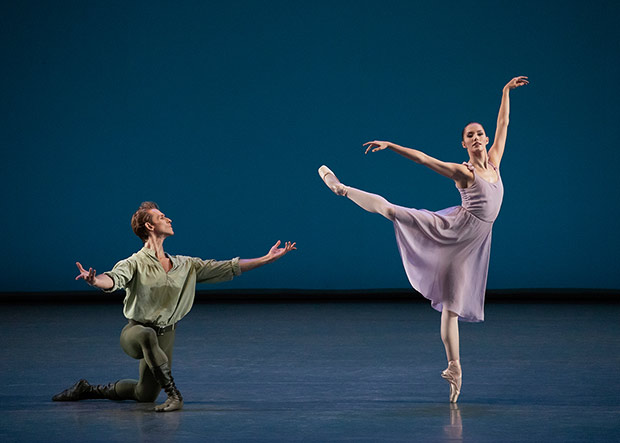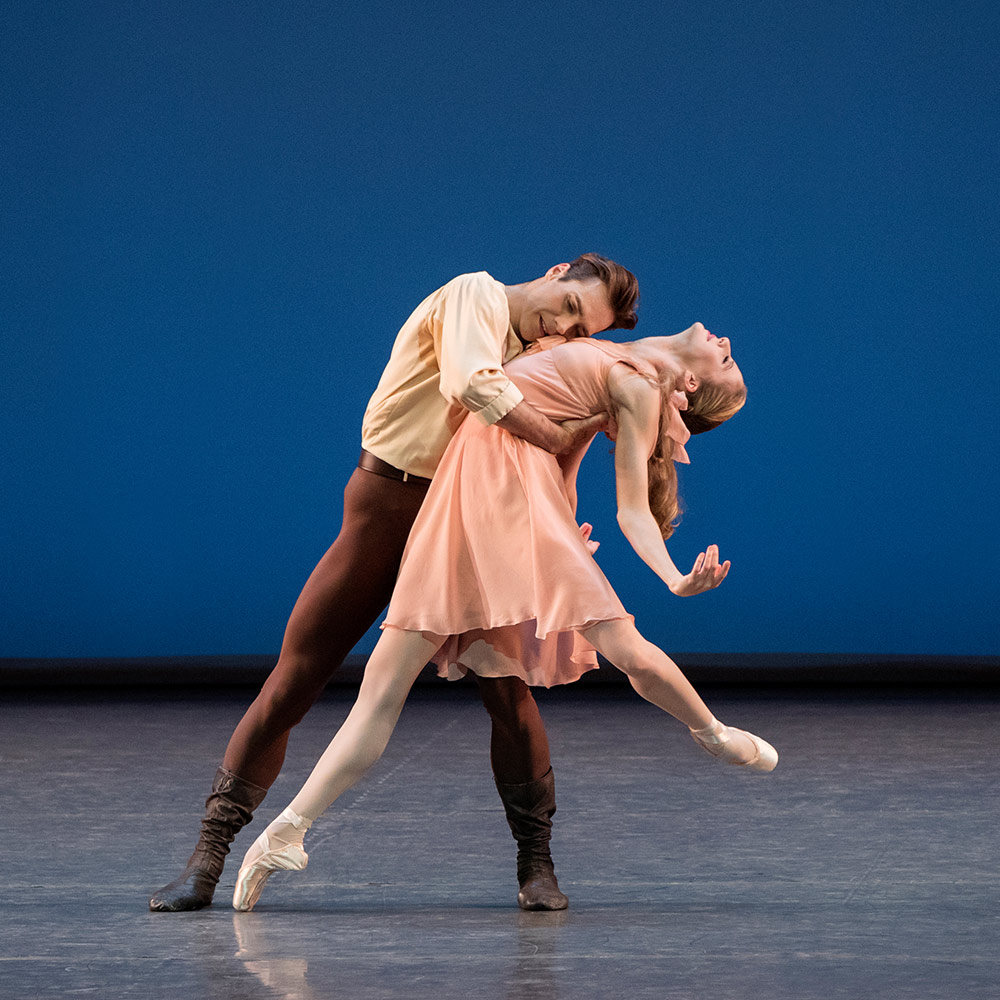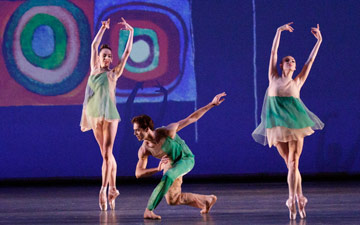
© Erin Baiano. (Click image for larger version)
New York City Ballet
Dances at a Gathering, Everywhere We Go
★★★✰✰
New York, David H. Koch Theater
3 October 2019
www.nycballet.com
davidhkochtheater.com
The Here and Now
The title of the ballet Dances at a Gathering is apt. In his 1969 work, Jerome Robbins managed to convey something rare: the feeling of the stage as a real place, in which dancers gather to explore emotions. (There is a bit of this in Balanchine’s Liebeslieder Walzer as well.) Near the end, the ten dancers join in a large circle and bow to each other, as if thanking each other for taking part. Each dancer is an individual, as well as part of the group. They appear in combinations of one, two, three, or more, but almost never all at once. And each role has a different tone, which makes casting particularly important. While watching today’s cast, you see traces of previous dancers you’ve particularly loved in this or that role. The feeling of being among friends and of experiencing memories with them – which is the theme of the ballet – is powerful.
Robbins made the ballet after returning to New York City Ballet after an absence of 13 years; it was a homecoming, suffused with the poignancy of his long absence. Robbins was also reflecting on a Slavic idyll of his mind; a nostalgia-tinged utopia before wars scarred and tore apart the European continent. Of course, this time and place never existed, and yet we see its traces in the folk elements in the choreography: a hand behind the head, a toe/heel tap here, a stomp there. On October 3, I caught a cast led by Gonzalo García as the “man in brown” who first steps on the stage, in silence, conjuring up the other characters as if in his daydreams. After he enters, slowly, the first Chopin mazurka begins, ushering in a rush of memories.
Having seen the ballet dozens of times, I’m still amazed at its ability to cast a spell. The Chopin piano pieces to which it is set – mazurkas, waltzes, études, and, finally, a Nocturne – are an essential part of its emotional world, redolent with nostalgia and feeling. Susan Walters played with poignant directness, paying close attention to the music’s rhythmic impulse. But Robbins’ response to Chopin is also extraordinary: sensitive, simple, vulnerable, direct, un-fussy. The tools he uses are elemental: canons, repetition, marking time with just the arms or the feet, touch, lifts that seem to come out of nowhere.

© Paul Kolnik. (Click image for larger version)
Different moments of this hour-long work come to the fore at each performance. This often has to do with casting. Last night, I was particularly struck by Unity Phelan, a soloist who seems to dance in just about every ballet, melting into each part with chameleonic ease. In Dances, she is the “woman in mauve,” a delicate character who seems to carry a mantle of fragility and loneliness. Phelan doesn’t overact, but her face and gaze are an important part of her performance; she looks at her fellow dancers with love but also with a slightly lost quality. In a trio with two other women (Sterling Hyltin and Lauren King), she is separated from the others by a heartbreaking loneliness, which disappears only briefly, when a man in green (Adrian Danchig-Waring) appears. They walk together, almost shyly, their hands clasped behind their backs. Then he’s gone again.
Another moment that stood out at this performance was the duet known as the “giggle dance,” for Megan Fairchild and Roman Mejía. As its nickname suggests, it’s quick and light, like a game of tag. How well Fairchild is dancing these days, her feet quick and sharp, buoyed by an inner élan. Mejía, a young colt with huge jump, simply bursts with energy. Both make much of the conversational back-and-forth of the steps, the dueling arms that create counterpoint and syncopation. The section can come across as cute, but not with these two. The entire cast was strong, including Tyler Angle, who recovered from weakness in the legs early on to dance with warmth and his usual partnering finesse. Sterling Hyltin’s limpid shapes in the air and on pointe infuse her role with tenderness and spaciousness. The only false note was an over-emphatic rendition of the “woman in green” – the ballet’s eccentric grande dame – by Ashley Bouder.

© Erin Baiano. (Click image for larger version)
In the second half of the evening, the company performed Justin Peck’s 2014 extravaganza Everywhere We Go, a large ensemble work with a score by Sufjan Stevens. The worst element in the ballet is the score: alternatingly blaring and sentimental, unimaginative and often repetitive. The best is the combination of the geometric backdrop by Karl Jensen (and cathedral-like lighting by Brandon Stirling Baker) and the almost mathematically-precise choreography by Peck. Peck is a master of line and shape, dynamics and contrast. He seems to possess endless inventiveness in deploying the corps and finding ways to entwine and interlock their bodies. But when it comes to imbuing his imaginative formations with deeper meaning, he is on shakier ground.
Everywhere We Go is a perfect example. It begins with an intriguing theme of the individual and his shadow. A man (Russell Janzen) stands with another man (Taylor Stanley) lying behind him. The second man executes almost the same steps, horizontally rather than vertically. It’s such an ingenious idea that it returns later in the ballet, reversed. But it’s a motif without a reason behind it; nothing in the ballet suggests a deeper significance. Later, dancers crumple to the ground one by one, only to be caught and tended to by their colleagues. How are we meant to interpret this weakness? There are gestures at emotion in the piece, but they are vague, ambivalent. This ambivalence is present in a lot of Peck’s work.
Even so, there is much to enjoy, despite the piece’s excessive length and two false endings. Crisp groupings, the contrast of fast and slow, round and straight, staccato and legato. The way the steps fit so neatly and intelligently into each phrase. The fluidity with which soloists emerge from and melt back into the ensemble. And most of all, the vivid, alert performances Peck draws from the dancers.
But what is missing in Everywhere We Go is precisely the quality Dances at a Gathering captures so well. A sense of purpose, of significance, and of completeness.

















You must be logged in to post a comment.